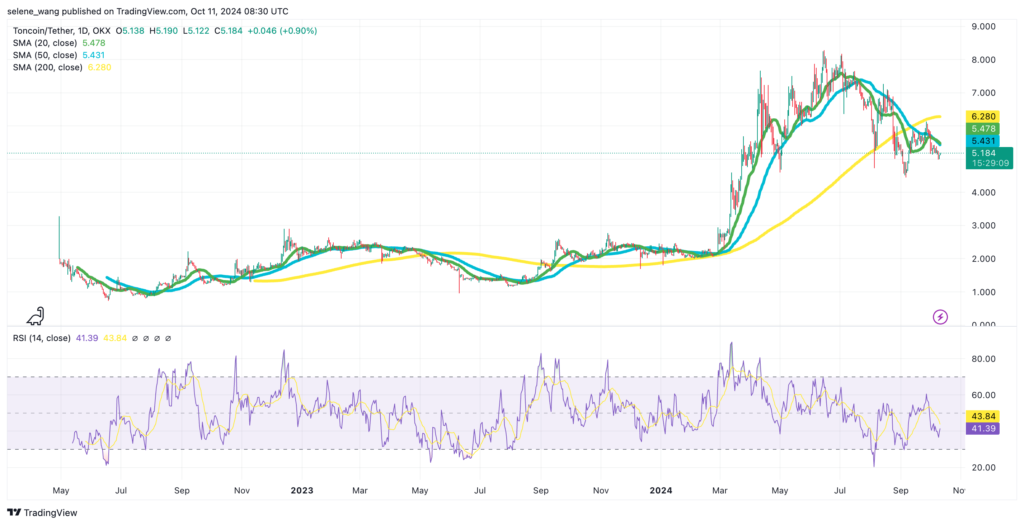Toncoin: A Global Social Media-Based Coin
By Selene Wang | Crescent City Capital Market Analyst Intern
1. Introduction to Toncoin
TON (The Open Network) is a Layer 1 smart contract network specializing in financial applications. It was first developed by Telegram’s co-founder Nikolai Durov known as “Telegram Open Network” but has been relaunched as “The Open Network” under the TON Foundation.
TON is a Proof of Stake (PoS) network with a focus on delivering a scalable network for financial activities and a medium for diverse users to interact over an immutable financial infrastructure. By adopting the PoS consensus algorithm and an overall flexible design, The Open Network hopes to develop a blockchain network that can be used by billions of users without breaking down or losing significant efficiency. The switch from Proof of Work (PoW) to Proof of Stake consensus is in line with this goal and also an attempt to adopt a more environmentally friendly consensus system.
2. How does it work
(1) A Proof-of-Stake (PoS) Consensus Algorithm
The nodes in a PoS consensus network are run by validators and not miners as seen on the PoW network. Instead of running complex mathematical procedures, validators in a PoS network are required to lock up their assets to the network as a form of commitment to their roles. Validators are selected to screen and approve new blocks before they are hashed into the blockchain. A validator’s chances of getting selected for this role depend on the number of tokens locked in their nodes. The more tokens locked in a validator’s node, the higher their chances of getting selected. The security and decentralization of a PoS network are relative to the validator count and the number of tokens locked on the network. An attacker must control at least 51% of the assets locked on the network to be able to influence the network (known as a 51% attack).
(2) Sharding
Sharding is a novel approach to blockchain scalability. TON consists of two major chains known as masterchains and workchains. Masterchains are the central coordinators of the networking managing validator nodes while workchains handle requests from smart contracts and dApps. On TON, workchains are split into multiple shards that each complete different tasks for more efficient transaction processing.
3. Tokenomics: The TON Token
Toncoin (TON) is the native token of The Open Network, used for transaction fees, staking, and governance. It powers the TON ecosystem, with validators and stakers receiving TON rewards for protecting the network. It also has an on-chain governance platform for TON holders to submit improvement proposals.
4. Market Analysis
(1) Price & Market Cap Performance:
- Live price: $5.79
- All-Time High: $8.25 (Jun 15, 2024)
- All-Time Low: $0.5194 (Sep 21, 2021)
- Live market cap: $14,664,553,015
- Circulating supply: 2,535,848,151 TON coins

(2) Past performance:
Toncoin was trading at about $0.5 in August 2021. By November 2021, the token surged to a then all-time high of over $5.8 buoyed by the ongoing bull market at the time.
Over the next year, Toncoin price stagnated as a crypto winter took over the market in 2022 following the collapse of algorithmic stablecoin issuer Terra and bankruptcy of several crypto companies including FTX Trading. The token hit a low of about $0.75 in June 2022.
In March 2024, TON increased by 14% following the launch of the Toncoin community rewards initiative, valued at over $100 million. Telegram now allows users to buy in-platform ads using Toncoin, enabling channel owners to promote their channels. The Telegram application has grown into one of the most used messaging applications, TON’s affiliation with a social application of this relevance is a huge boost in its goal of pushing the adoption of decentralized financial solutions.
In June 2024, TON price down -15.8% after breaking news reported that Telegram founder and CEO Pavel Durov arrested in France by National Anti-Fraud Office.
Currently, the cryptocurrency market is under a prevailing downtrend. With the ongoing bearish trend, a lot of coins, such as bitcoin, Ethereum, and Solana, are experiencing significant volatility. Market sentiment appears to be weakening, which could further exacerbate this decline. If this trend continues, Toncoin may continue drop to $4.
(3) Technical Analysis

- Relative Strength Index (RSI) Analysis: The RSI is currently at 41.39, which is in the neutral to slightly oversold territory. This suggests that there may be some potential for a price rebound if buying interest picks up. However, the RSI hasn’t yet reached the oversold threshold of 30, which would typically signal a stronger reversal opportunity.
- Moving Averages (SMA) Analysis: The SMA 20 (green line) and the SMA 50 (blue line) are currently overlapping, suggesting a moment of uncertainty or consolidation in the short-term price trend. This overlap often indicates a transition period where the market is deciding its next direction. The SMA 200 (yellow line) is above the current price, which generally confirms a bearish longer-term trend. The fact that the price remains below this moving average indicates downward pressure.
5. Summary
Toncoin, now managed by the TON Foundation, was initially developed by Telegram and serves as a Layer 1 smart contract network, specifically designed for financial applications. Its scalability is powered by sharding, which divides tasks among masterchains and workchains, allowing for efficient and parallel processing of transactions.
Currently, Toncoin faces downward pressure in the market, as indicated by both recent news and technical analysis. Traders should be cautious, as further declines are possible if support levels are breached. This bearish trend could signal more potential losses in the near term.
Reference
https://coinmarketcap.com/currencies/toncoin
https://www.coingecko.com/learn/what-is-ton-toncoin-crypto
https://www.techopedia.com/news/whats-behind-tons-price-surge-millions-of-telegram-users

